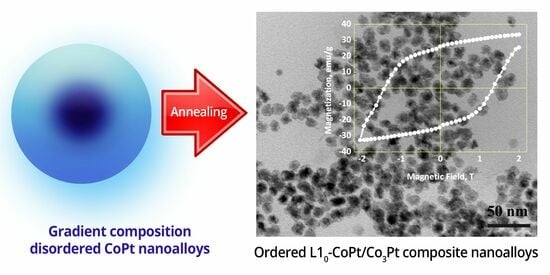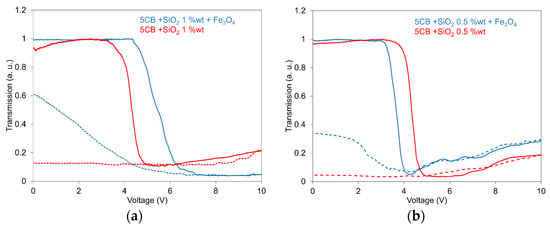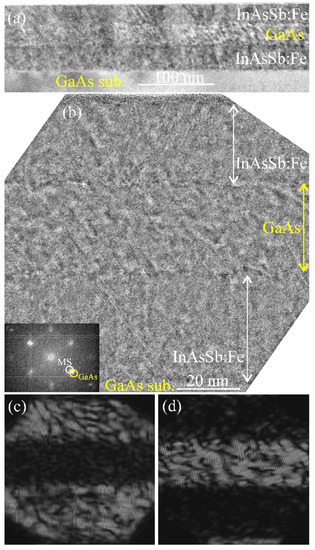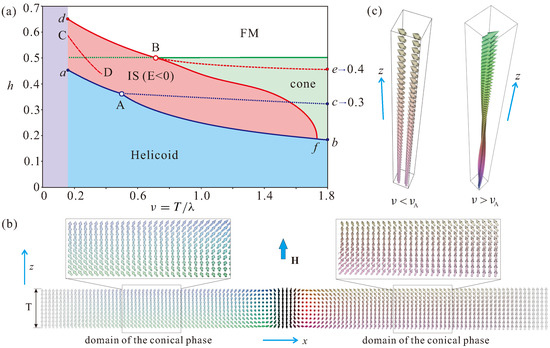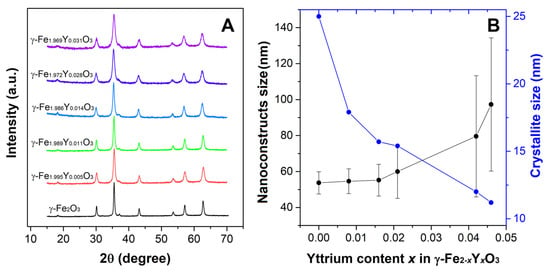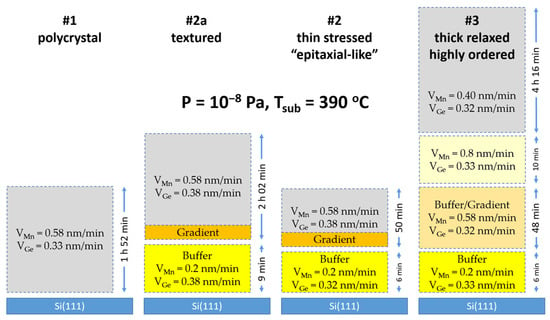Magnetic Nanostructured Materials: Synthesis, Characterization and Their Cutting-Edge Applications
Share This Topical Collection
Editors
 Dr. Vasileios Tzitzios
Dr. Vasileios Tzitzios
 Dr. Vasileios Tzitzios
Dr. Vasileios Tzitzios
E-Mail
Website1
Website2
Collection Editor
Institute of Nanoscience and Nanotechnology, National Centre for Scientific Research, “Demokritos”, 15310 Athens, Greece
Interests: magnetic colloidal particles; liquid phase synthesis; L1
0 chemical ordering; FePt; CoPt; Fe
3O
4; nanomagnetism; biomedical applications of magnetic nanoparticles; catalysis
Special Issues, Collections and Topics in MDPI journals
 Dr. Georgia Basina
Dr. Georgia Basina
 Dr. Georgia Basina
Dr. Georgia Basina
E-Mail
Website1
Website2
Collection Editor
Institute of Nanoscience and Nanotechnology, National Centre for Scientific Research, “Demokritos”, 15310 Athens, Greece
Interests: Nanoparticles synthesis; Fe3O4; γ-Fe2O3; Biomedical; environmental and catalytic applications of magnetic nanomaterials
Topical Collection Information
In the early 1930s, Frenkel and Dorfman predicted that a particle of ferromagnetic material with a size below a critical limit would possess a single magnetic domain within which magnetic moments of free electrons are aligned in parallel. Since then, there has been a continuously increasing interest in the scientific community for the development and study of magnetic materials in the nanoscale size regime. This enormous interest is mainly due to their prospective applications in many technological areas, including magnetic storage devices, ferrofluids, magnetic resonance imaging, magnetic carriers, magnetic hyperthermia environmental remedation protection, energy and catalysis. Recently, there has additionally been a great interest for the synthesis of 2D magnetic materials, which seem to offer potential for significant improvements in spintronic applications.
The present collection is aimed at presenting the current state-of-the-art in the synthesis of magnetic nanomaterials in both particles and thin-layered forms, as well as their advanced characterization and niche applications. In this collection, we are inviting contributions from leading groups in the field aiming to present a comprehensive view of the progress in this discipline.
Dr. Vasileios Tzitzios
Dr. Georgia Basina
Collection Editors
Manuscript Submission Information
Manuscripts should be submitted online at www.mdpi.com by registering and logging in to this website. Once you are registered, click here to go to the submission form. Manuscripts can be submitted until the deadline. All submissions that pass pre-check are peer-reviewed. Accepted papers will be published continuously in the journal (as soon as accepted) and will be listed together on the collection website. Research articles, review articles as well as short communications are invited. For planned papers, a title and short abstract (about 100 words) can be sent to the Editorial Office for announcement on this website.
Submitted manuscripts should not have been published previously, nor be under consideration for publication elsewhere (except conference proceedings papers). All manuscripts are thoroughly refereed through a single-blind peer-review process. A guide for authors and other relevant information for submission of manuscripts is available on the Instructions for Authors page. Nanomaterials is an international peer-reviewed open access semimonthly journal published by MDPI.
Please visit the Instructions for Authors page before submitting a manuscript.
The Article Processing Charge (APC) for publication in this open access journal is 2900 CHF (Swiss Francs).
Submitted papers should be well formatted and use good English. Authors may use MDPI's
English editing service prior to publication or during author revisions.
Keywords
- magnetic nanomaterials
- colloidal particles
- thin films
- synthesis
- nanomagnetism
- 2D magnetism
- magnetic characterization
- composite magnets
- L10 ordering
- nanomagnets applications
Published Papers (8 papers)
Open AccessArticle
Low-Platinum-Content Exchange-Coupled CoPt Nanoalloys with Enhanced Magnetic Properties
by
Georgia Basina, Vasileios Alexandrakis, Ioannis Panagiotopoulos, Dimitrios Niarchos, Eamonn Devlin, Margarit Gjoka, George C. Hadjipanayis and Vasileios Tzitzios
Viewed by 1122
Abstract
Bimetallic colloidal CoPt nanoalloys with low platinum content were successfully synthesized following a modified polyol approach. Powder X-ray diffraction (XRD), Fourier transform infrared spectroscopy (FT-IR), thermogravimetric analysis (TGA), and transmission electron microscopy (TEM) studies were performed to estimate the crystal structure, morphology, and
[...] Read more.
Bimetallic colloidal CoPt nanoalloys with low platinum content were successfully synthesized following a modified polyol approach. Powder X-ray diffraction (XRD), Fourier transform infrared spectroscopy (FT-IR), thermogravimetric analysis (TGA), and transmission electron microscopy (TEM) studies were performed to estimate the crystal structure, morphology, and surface functionalization of the colloids, respectively, while the room-temperature magnetic properties were measured using a vibrating sample magnetometer (VSM). The particles exhibit excellent uniformity, with a narrow size distribution, and display strong room-temperature hysteretic ferromagnetic behavior even in the as-made form. Upon annealing at elevated temperatures, progressive formation and co-existence of exchange coupled, of both chemically ordered and disordered phases significantly enhanced the room-temperature coercivity.
Full article
►▼
Show Figures
Open AccessArticle
Study on the Memory Effect in Aerosil-Filled Nematic Liquid Crystal Doped with Magnetic Nanoparticles
by
Peter Bury, Marek Veveričík, František Černobila, Natália Tomašovičová, Veronika Lacková, Katarína Zakutanská, Milan Timko and Peter Kopčanský
Cited by 1 | Viewed by 714
Abstract
A study on 5CB liquid crystal composites with SiO
2 nanoparticles and an additional commixture with Fe
3O
4 nanoparticles using light transmission and SAW measurements is presented. The prepared liquid crystal composites exhibited an interesting memory effect characterized by the hysteresis
[...] Read more.
A study on 5CB liquid crystal composites with SiO
2 nanoparticles and an additional commixture with Fe
3O
4 nanoparticles using light transmission and SAW measurements is presented. The prepared liquid crystal composites exhibited an interesting memory effect characterized by the hysteresis of both light transmission and SAW attenuation responses investigated in the nematic phase. While in the case of SiO
2 nanoparticles as dopants, the liquid crystal composite showed an improvement in the memory effect, the addition of Fe
3O
4 magnetic nanoparticles resulted in the memory effect decreasing. Additional studies showed a significant shift in both the threshold voltage and nematic–isotropic transition temperature. Measurements in the magnetic field confirmed the increasing memory effect according to that of pure 5CB. The properties of these composites could lead to a potential application for the fabrication of memory devices suitable for information storage.
Full article
►▼
Show Figures
Open AccessArticle
Multilayer Epitaxial Heterostructures with Multi-Component III–V:Fe Magnetic Semiconductors
by
Alexey V. Kudrin, Valeri P. Lesnikov, Ruslan N. Kriukov, Yuri A. Danilov, Mikhail V. Dorokhin, Anastasia A. Yakovleva, Nataliya Yu. Tabachkova and Nikolai A. Sobolev
Viewed by 777
Abstract
Three-layer structures based on various multi-component films of III–V semiconductors heavily doped with Fe were grown using the pulsed laser sputtering of InSb, GaSb, InAs, GaAs and Fe solid targets. The structures comprising these InAsSb:Fe, InGaSb:Fe and InSb:Fe layers with Fe concentrations up
[...] Read more.
Three-layer structures based on various multi-component films of III–V semiconductors heavily doped with Fe were grown using the pulsed laser sputtering of InSb, GaSb, InAs, GaAs and Fe solid targets. The structures comprising these InAsSb:Fe, InGaSb:Fe and InSb:Fe layers with Fe concentrations up to 24 at. % and separated by GaAs spacers were deposited on (001)
i-GaAs substrates at 200 °C. Transmission electron microscopy showed that the structures have a rather high crystalline quality and do not contain secondary-phase inclusions. X-ray photoelectron spectroscopy investigations revealed a significant diffusion of Ga atoms from the GaAs regions into the InAsSb:Fe layers, which has led to the formation of an InGaAsSb:Fe compound with a Ga content up to 20 at. %. It has been found that the ferromagnetic properties of the InAsSb:Fe magnetic semiconductor improve with an increasing Sb:As ratio. It has been concluded that the indirect ferromagnetic exchange interaction between Fe atoms occurs predominantly via Sb atoms.
Full article
►▼
Show Figures
Open AccessArticle
Landau Diamagnetism and de Haas–van Alphen Oscillations, Formed in Single Crystals of Y3Fe5O12, in Local Nanodimensional-Sized 2D Phase Separation Regions, Located inside Layered Domain Walls at Room Temperature and T = 77 K
by
Boris Khannanov, Evgeny Golovenchits, Mikhail Shcheglov and Viktoriya Sanina
Viewed by 705
Abstract
This paper presents results of the magnetic dynamics study (the microwave power absorptions at the fixed frequencies during magnetic field sweeping) in samples of Y
3Fe
5O
12 single crystals in the form of plates and spheres of various sizes, at
[...] Read more.
This paper presents results of the magnetic dynamics study (the microwave power absorptions at the fixed frequencies during magnetic field sweeping) in samples of Y
3Fe
5O
12 single crystals in the form of plates and spheres of various sizes, at frequencies exceeding 30 GHz, in magnetic fields up to 18 kOe, at room temperature, and T = 77 K. It was found that in this case, the inhomogeneity’s of the magnetic state manifested itself in the Y
3Fe
5O
12 samples as 2D local phase separation regions. Such 2D phase separation regions formed inside layered domain walls representing superlattices with sizes of 700–900 Å. Depending on the shape and size of the studied plates and spheres, Landau diamagnetism or de Haas–van Alphen oscillations were observed in the 2D phase separation regions at room temperature and T = 77 K.
Full article
►▼
Show Figures
Open AccessArticle
Harnessing Skyrmion Hall Effect by Thickness Gradients in Wedge-Shaped Samples of Cubic Helimagnets
by
Takayuki Shigenaga and Andrey O. Leonov
Cited by 3 | Viewed by 1087
Abstract
The skyrmion Hall effect, which is regarded as a significant hurdle for skyrmion implementation in thin-film racetrack devices, is theoretically shown to be suppressed in wedge-shaped nanostructures of cubic helimagnets. Under an applied electric current, ordinary isolated skyrmions with the topological charge 1
[...] Read more.
The skyrmion Hall effect, which is regarded as a significant hurdle for skyrmion implementation in thin-film racetrack devices, is theoretically shown to be suppressed in wedge-shaped nanostructures of cubic helimagnets. Under an applied electric current, ordinary isolated skyrmions with the topological charge 1 were found to move along the straight trajectories parallel to the wedge boundaries. Depending on the current density, such skyrmion tracks are located at different thicknesses uphill along the wedge. Numerical simulations show that such an equilibrium is achieved due to the balance between the Magnus force, which instigates skyrmion shift towards the wedge elevation, and the force, which restores the skyrmion position near the sharp wedge boundary due to the minimum of the edge–skyrmion interaction potential. Current-driven dynamics is found to be highly non-linear and to rest on the internal properties of isolated skyrmions in wedge geometries; both the skyrmion size and the helicity are modified in a non-trivial way with an increasing sample thickness. In addition, we supplement the well-known theoretical phase diagram of states in thin layers of chiral magnets with new characteristic lines; in particular, we demonstrate the second-order phase transition between the helical and conical phases with mutually perpendicular wave vectors. Our results are useful from both the fundamental point of view, since they systematize the internal properties of isolated skyrmions, and from the point of view of applications, since they point to the parameter region, where the skyrmion dynamics could be utilized.
Full article
►▼
Show Figures
Open AccessArticle
Self-Heating Flower-like Nanoconstructs with Limited Incorporation of Yttrium in Maghemite: Effect of Chemical Composition on Heating Efficiency, Cytotoxicity and Genotoxicity
by
Miloš Ognjanović, Željko Jaćimović, Milica Kosović-Perutović, Irina Besu Žižak, Tatjana Stanojković, Željko Žižak, Biljana Dojčinović, Dalibor M. Stanković and Bratislav Antić
Viewed by 1863
Abstract
Partial cation substitution can significantly change the physical properties of parent compounds. By controlling the chemical composition and knowing the mutual relationship between composition and physical properties, it is possible to tailor the properties of materials to those that are superior for desired
[...] Read more.
Partial cation substitution can significantly change the physical properties of parent compounds. By controlling the chemical composition and knowing the mutual relationship between composition and physical properties, it is possible to tailor the properties of materials to those that are superior for desired technological application. Using the polyol synthesis procedure, a series of yttrium-substituted iron oxide nanoconstructs, γ-Fe
2−xY
xO
3 (YIONs), was prepared. It was found that Y
3+ could substitute Fe
3+ in the crystal structures of maghemite (γ-Fe
2O
3) up to a limited concentration of ~1.5% (γ-Fe
1.969Y
0.031O
3). Analysis of TEM micrographs showed that crystallites or particles were aggregated in flower-like structures with diameters from 53.7 ± 6.2 nm to 97.3 ± 37.0 nm, depending on yttrium concentration. To be investigated for potential applications as magnetic hyperthermia agents, YIONs were tested twice: their heating efficiency was tested and their toxicity was investigated. The Specific Absorption Rate (
SAR) values were in the range of 32.6 W/g to 513 W/g and significantly decreased with increased yttrium concentration in the samples. Intrinsic loss power (
ILP) for γ-Fe
2O
3 and γ-Fe
1.995Y
0.005O
3 were ~8–9 nH·m
2/Kg, which pointed to their excellent heating efficiency. IC
50 values of investigated samples against cancer (HeLa) and normal (MRC-5) cells decreased with increased yttrium concentration and were higher than ~300 μg/mL. The samples of γ-Fe
2−xY
xO
3 did not show a genotoxic effect. The results of toxicity studies show that YIONs are suitable for further in vitro/in vivo studies toward to their potential medical applications, while results of heat generation point to their potential use in magnetic hyperthermia cancer treatment or use as self-heating systems for other technological applications such as catalysis.
Full article
►▼
Show Figures
Open AccessArticle
Exploring the Magnetic and Electrocatalytic Properties of Amorphous MnB Nanoflakes
by
Boxiao Fu, Vasileios Tzitzios, Qiancheng Zhang, Brian Rodriguez, Michael Pissas and Maria Veronica Sofianos
Cited by 2 | Viewed by 2032
Abstract
Two-dimensional (2D) metal borides are a class of ceramic materials with diverse structural and topological properties. These diverse material properties of metal borides are what forms the basis of their interdisciplinarity and their applicability in various research fields. In this study, we highlight
[...] Read more.
Two-dimensional (2D) metal borides are a class of ceramic materials with diverse structural and topological properties. These diverse material properties of metal borides are what forms the basis of their interdisciplinarity and their applicability in various research fields. In this study, we highlight which fundamental and practical parameters need to be taken into consideration when designing nanomaterials for specific applications. A simple one-pot chemical reduction method was applied for the synthesis of manganese mono-boride nanoflakes at room temperature. How the specific surface area and boron-content of the as-synthesized manganese mono-boride nanoflakes influence their magnetic and electrocatalytic properties is reported. The sample with the highest specific surface area and boron content demonstrated the best magnetic and electrocatalytic properties in the HER. Whereas the sample with the lowest specific surface area and boron content exhibited the best electric conductivity and electrocatalytic properties in the OER.
Full article
►▼
Show Figures
Open AccessArticle
Sublayer-Enhanced Growth of Highly Ordered Mn5Ge3 Thin Film on Si(111)
by
Ivan Yakovlev, Ivan Tarasov, Anna Lukyanenko, Mikhail Rautskii, Leonid Solovyov, Alexander Sukhachev, Mikhail Volochaev, Dmitriy Efimov, Aleksandr Goikhman, Ilya Bondarev, Sergey Varnakov, Sergei Ovchinnikov, Nikita Volkov and Anton Tarasov
Cited by 1 | Viewed by 1740
Abstract
Mn
5Ge
3 epitaxial thin films previously grown mainly on Ge substrate have been synthesized on Si(111) using the co-deposition of Mn and Ge at a temperature of 390 °C. RMS roughness decreases by almost a factor of two in the transition
[...] Read more.
Mn
5Ge
3 epitaxial thin films previously grown mainly on Ge substrate have been synthesized on Si(111) using the co-deposition of Mn and Ge at a temperature of 390 °C. RMS roughness decreases by almost a factor of two in the transition from a completely polycrystalline to a highly ordered growth mode. This mode has been stabilized by changing the ratio of the Mn and Ge evaporation rate from the stoichiometric in the buffer layer. Highly ordered Mn
5Ge
3 film has two azimuthal crystallite orientations, namely Mn
5Ge
3 (001) [1-10] and Mn
5Ge
3 (001) [010] matching Si(111)[-110]. Lattice parameters derived
a (7.112(1) Å) and
c (5.027(1) Å) are close to the bulk values. Considering all structural data, we proposed a double buffer layer model suggesting that all layers have identical crystal structure with P6₃/mcm symmetry similar to Mn
5Ge
3, but orientation and level of Si concentration are different, which eliminates 8% lattice mismatch between Si and Mn
5Ge
3 film. Mn
5Ge
3 film on Si(111) demonstrates no difference in magnetic properties compared to other reported films. T
C is about 300 K, which implies no significant excess of Mn or Si doping. It means that the buffer layer not only serves as a platform for the growth of the relaxed Mn
5Ge
3 film, but is also a good diffusion barrier.
Full article
►▼
Show Figures







